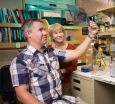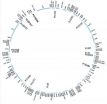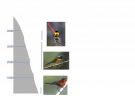Salk Institute study identifies novel regulator of key gene expression in cancer
Findings may lead to new targets for cancer treatment
2014-04-30
(Press-News.org) LA JOLLA—Scientists at the Salk Institute for Biological Studies have identified a key genetic switch linked to the development, progression and outcome of cancer, a finding that may lead to new targets for cancer therapies.
The switch, a string of nucleotides dubbed a long non-coding RNA (lncRNA), does not code for proteins like regular RNA. Instead, the scientists found, this particular lncRNA acts as an on/off switch for a key gene whose excessive activity is tied to inflammation and cancer, COX-2.
The COX-2 gene mediates inflammation, which in most cases helps our bodies eliminate pathogens and damaged cells. But inflammation also has a dark side: it aids growth and spread of tumors in the early stages of cancer. By learning more about how COX-2 is affected, scientists may be able to provide a potential target for future cancer treatment.
"Deciphering the mechanism of COX-2 gene regulation is of great clinical interest," says senior author Beverly Emerson, a professor in Salk's Regulatory Biology Laboratory and holder of the Edwin K. Hunter Chair. "COX-2 is instrumental in the development of several types of cancer, including colon, breast and prostate cancer. Strategies that specifically modulate COX-2 activity could be an attractive treatment approach."
The findings of the study were published April 29 in the open-access online journal eLife.
The function of lncRNAs is not well understood, but evidence increasingly points to their role in regulating gene expression, as they are found overexpressed in esophageal, colorectal and breast cancers.
Using human mammary epithelial cells, Emerson and Michal Krawczyk, a senior scientist in Salk's Regulatory Biology Laboratory, discovered that an lncRNA called PACER (p50-associated COX-2 extragenic RNA) teams up with molecules that change the activity of the COX-2 gene. The scientists demonstrated that PACER kicks a molecule called p50 off of the COX-2 gene, causing COX-2 to go into overdrive. This is the first time scientists have shown that non-coding RNAs must be activated in order to squelch the activity of p50, a gene repressor. In turn, says Krawczyk, blocking p50 promotes the assembly of molecular activators of gene expression, which ramp up COX-2 activity.
The Salk scientists were also surprised to note an additional potential role for PACER-induced COX-2 activation in cancer. Early in the disease process, instead of activating the immune system to clear malignant cells from the body, COX-2 aids the growth and spread of tumors. In later stages of disease, however, Krawczyk says cancer cells often shut off COX-2 activity, as if at that stage COX-2 is no longer beneficial for tumor growth because it exposes spreading tumor cells to the immune system. That presents the opportunity to trigger COX-2 expression via PACER in late-stage cancers to aid immune system clearance of metastatic cells.
"This could be a potential treatment for late-stage cancers," says Krawczyk. "We could possibly use small molecules to reactivate COX-2 activity, or perhaps even supply PACER itself, to fight the disease."INFORMATION:
The work was supported by the National Institutes of Health, the Chambers Medical Foundation and the GemCon Foundation.
About the Salk Institute for Biological StudiesThe Salk Institute for Biological Studies is one of the world's preeminent basic research institutions, where internationally renowned faculty probe fundamental life science questions in a unique, collaborative, and creative environment. Focused on both discovery and on mentoring future generations of researchers, Salk scientists make groundbreaking contributions to our understanding of cancer, aging, Alzheimer's, diabetes and infectious diseases by studying neuroscience, genetics, cell and plant biology, and related disciplines.
Faculty achievements have been recognized with numerous honors, including Nobel Prizes and memberships in the National Academy of Sciences. Founded in 1960 by polio vaccine pioneer Jonas Salk, M.D., the Institute is an independent nonprofit organization and architectural landmark.
ELSE PRESS RELEASES FROM THIS DATE:
New revolutionary sensor links pressure to color change
2014-04-30
RIVERSIDE, Calif. — Imagine an automobile crash test that uses test dummies painted all over with a substance that can change color according to the levels of stress that various parts of the dummies' bodies will endure. Such a "color map" could provide vital information to engineers designing safer automobiles.
Or imagine baseball gloves that when worn show the batters if they are using the appropriate amount of pressure to grip their bats, resulting in better performance.
New technology developed at the University of California, Riverside may now make the above and ...
EARTH Magazine: Precise to a fault: How GPS revolutionized seismic research
2014-04-30
Alexandria, Va., - Global Positioning System (GPS) technology was conceived in the 1960s to provide precise time and location data to the U.S. military, but it was soon embraced by geodesists and earth scientists. The first major test of GPS as a seismic tool occurred on Oct. 17, 1989, when the Loma Prieta earthquake struck San Francisco just as the third game of the World Series was about to begin at Candlestick Park. The quake killed 63 people, injured several thousand and caused an estimated $6 billion in damage.
Prior to the quake, geoscientists had placed GPS markers ...
Simple sequence repeats for population-level studies of pines
2014-04-30
Simple sequence repeats, abbreviated SSRs and frequently referred to as microsatellites, are highly variable sections of the genome. 'Sequence repeat' refers to the fact that a nucleotide motif is repeated. 'Simple,' because the repeated sequence often consists of only a couple of nucleotides—for example, ATAT.
Because these markers typically have high rates of molecular evolution, the number of repeats present in the genome often differs between individuals. By isolating SSRs and comparing length differences between taxa, evolutionary relationships can be inferred. Their ...
Regenerative medicine approach improves muscle strength, function in leg injuries
2014-04-30
PITTSBURGH, April 30, 2014 – Damaged leg muscles grew stronger and showed signs of regeneration in three out of five men whose old injuries were surgically implanted with extracellular matrix (ECM) derived from pig bladder, according to a new study conducted by researchers at the University of Pittsburgh School of Medicine and the McGowan Institute for Regenerative Medicine. Early findings from a human trial of the process and from animal studies were published today in Science Translational Medicine.
When a large volume of muscle is lost, typically due to trauma, the ...
Frozen meal eaters get more vegetables including greens, beans and whole grains but with lower total calories vs. fast food restaurant eaters
2014-04-30
SAN DIEGO (April 30, 2014) – New analysis of data from the 2003-2010 What We Eat In America (WWEIA) National Health and Nutrition Examination Survey (NHANES), a program of the Centers for Disease Control and Prevention (CDC), indicates that consumers of frozen meals (1) compared to consumers of quick service restaurant (QSR) meals (2) had lower calorie intakes and better Healthy Eating Index (HEI) score. In fact, the analysis revealed that those who consumed frozen meals consumed 253 fewer calories than those who consumed a quick service restaurant meal.
These results ...
Competition for ecological niches limits the formation of new species
2014-04-30
The rate at which new species evolve is limited by competition for ecological niches, report scientists from the University of Chicago in Nature on April 30. The study, which analyzes the evolutionary and genetic relationships between all 461 songbird species that live in the Himalayan mountains, suggests that as ecological niches within an environment are filled, the formation of new species slows or even stops.
To study what controls the process of speciation, Trevor Price, PhD, professor of ecology and evolution at the University of Chicago, Dhananjai Mohan of the ...
Initial research: Mango's effects on ulcerative colitis & bone parameters in animal models
2014-04-30
SAN DIEGO, CA – April 30, 2014 – Three new mango-related studies were presented this week at the 2014 Federation of American Societies for Experimental Biology (FASEB) in San Diego, revealing initial findings on the effects of mango consumption on ulcerative colitis and bone parameters in animal models.
"The mango industry's nutrition research program is committed to advancing our understanding of the role mangos can play as part of a healthy diet," said Megan McKenna, Director of Marketing for the National Mango Board. "These studies provide important insights that ...
Multiple consecutive days of tornado activity spawn worst events
2014-04-30
WEST LAFAYETTE, Ind. - Significant tornado outbreaks and especially strong tornadoes are more likely occur within periods of activity lasting three or more days, according to a Purdue University tornado expert.
Jeff Trapp, a professor of earth, atmospheric and planetary sciences, examined 30 years of U.S. weather records and found that an outbreak of 20 or more reported tornadoes had a 74 percent probability of occurring during a period of tornado activity lasting three or more days. During those same periods, a tornado rated 3 or higher on the Enhanced Fujita scale had ...
MS researchers find brain & cognitive reserve protect long-term against cognitive decline
2014-04-30
West Orange, NJ. April 30, 2014. Multiple sclerosis researchers have found that brain reserve and cognitive reserve confer a long-term protective effect against cognitive decline: Sumowski JF, Rocca MA, Leavitt VM, Dackovic J, Mesaros S, Drulovic J, Deluca J, Filippi M. Brain reserve and cognitive reserve protect against cognitive decline over 4.5 years in MS. Neurology. 2014 Apr 18. doi: 10.1212/WNL.0000000000000433 [Epub ahead of print]. James Sumowski, PhD, lead author of the article, and John DeLuca, PhD, are at Kessler Foundation. Co-authors are from the Manhattan ...
'US Should significantly reduce rate of incarceration,' says new report
2014-04-30
WASHINGTON -- Given the minimal impact of long prison sentences on crime prevention and the negative social consequences and burdensome financial costs of U.S. incarceration rates, which have more than quadrupled in the last four decades, the nation should revise current criminal justice policies to significantly reduce imprisonment rates, says a new report from the National Research Council.
A comprehensive review of data led the committee that wrote the report to conclude that the costs of the current rate of incarceration outweigh the benefits. The committee recommended ...
LAST 30 PRESS RELEASES:
Making lighter work of calculating fluid and heat flow
Normalizing blood sugar can halve heart attack risk
Lowering blood sugar cuts heart attack risk in people with prediabetes
Study links genetic variants to risk of blinding eye disease in premature infants
Non-opioid ‘pain sponge’ therapy halts cartilage degeneration and relieves chronic pain
AI can pick up cultural values by mimicking how kids learn
China’s ecological redlines offer fast track to 30 x 30 global conservation goal
Invisible indoor threats: emerging household contaminants and their growing risks to human health
Adding antibody treatment to chemo boosts outcomes for children with rare cancer
Germline pathogenic variants among women without a history of breast cancer
Tanning beds triple melanoma risk, potentially causing broad DNA damage
Unique bond identified as key to viral infection speed
Indoor tanning makes youthful skin much older on a genetic level
Mouse model sheds new light on the causes and potential solutions to human GI problems linked to muscular dystrophy
The Journal of Nuclear Medicine ahead-of-print tip sheet: December 12, 2025
Smarter tools for peering into the microscopic world
Applications open for funding to conduct research in the Kinsey Institute archives
Global measure underestimates the severity of food insecurity
Child survivors of critical illness are missing out on timely follow up care
Risk-based vs annual breast cancer screening / the WISDOM randomized clinical trial
University of Toronto launches Electric Vehicle Innovation Ontario to accelerate advanced EV technologies and build Canada’s innovation advantage
Early relapse predicts poor outcomes in aggressive blood cancer
American College of Lifestyle Medicine applauds two CMS models aligned with lifestyle medicine practice and reimbursement
Clinical trial finds cannabis use not a barrier to quitting nicotine vaping
Supplemental nutrition assistance program policies and food insecurity
Switching immune cells to “night mode” could limit damage after a heart attack, study suggests
URI-based Global RIghts Project report spotlights continued troubling trends in worldwide inhumane treatment
Neutrophils are less aggressive at night, explaining why nighttime heart attacks cause less damage than daytime events
Menopausal hormone therapy may not pose breast cancer risk for women with BRCA mutations
Mobile health tool may improve quality of life for adolescent and young adult breast cancer survivors
[Press-News.org] Salk Institute study identifies novel regulator of key gene expression in cancerFindings may lead to new targets for cancer treatment




